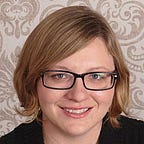Robotic mice & the emergence of households
Friday Seminar Wrap up! The Ovi Chris Rouly Series
There are a lot of awesome presenters that visit the department at George Mason University. Ovi Chris Rouly, PhD Candidate, spoke at the Friday series in the Computational Social Science Department twice this past semester. Each talk was interesting on its own, but together you can see that Rouly is interested in the core underpinnings of what makes up a lot of the assumptions that we take for granted in other models.
Alife: Using Adaptive, Autonomous, and Individual Agent Control
Talk delivered: Feb. 13, 2015
Rouly was the first talk that I had attended in the department that has a physical model — one that you could touch and hold. He displayed pictures of the model setup, but what he brought in was the individual agent — a little robotic mouse. He worked to program the mouse to be an adaptive and autonomous, as the talk title suggests. The mouse was a physical manifestation of Alan Turing’s algorithm to create a machine that is able of ‘cybernetic self-organization’ or basically, making its own decisions based on feedback. These are called P-type machines. Rouly’s experiments tested Turing’s algorithm, which Rouly hypothesized didn’t have enough detail and/or wouldn’t work the way in which they were described. In the model, Rouly made the algorithm work, with his mouse being able to adapt to the environment as a result of exposure to pleasure and pain stimuli.
More about Rouly’s prototype: Rodent Model (P-Type Agency)
More on Turing: Alan Turing, Father of the Modern Computer
At the root of sociality: Working towards emergent, permanent, social affines
Talk delivered: April 24, 2015
Later in the semester, Rouly came back to discuss the origins of complexity as it relates to household units. According to Rouly, much of the complexity research assumes the base unit of a household. Rouly questioned this assumption and tried to figure out what conditions were needed to pull a household together:
“Why did our species transition from polygamy and promiscuity to permanent breeding bonds then affine relationship and reciprocal exogamy?”
Instead of coding in infant mortality rates when using a household as a base Rouly wanted to know how we could make households emerge in an agent-based model? Rouly highlighted that this is challenging, because social behavior is not recorded in fossils, gender wanderings for sex (sometimes it is men who wander, sometimes it is women), and changes in brain size over time. His hypothesis was to look at social altruism or more simplified — the act of ‘gifting’.
Two main rules:
1. In males, “gifting” extends only to sexually mature females.
2. In females, “gifting” extends only the youngest juvenile (post-weaning, pre-sexually mature) beneficiary male or female who is the immediate offspring of the female “gifter”.
In the end, Rouly presented two major runnings of the model he built. The first started with 1000 promiscuous agents spread over the terrain. After 8800+ years, they collected around water holes. The second, pictured on the left, started with 1000 altruistic agents and ran for 2425 years. The agents were consolidated to a single location. Over 240k agents were born and died.
Rouly is still digesting the information from the model, but he did share the result of the resulting network structure.
